|
Winmate FM10 modular vehicle-mount PC
Intel "Bay Trail" based industrial vehicle-mount PC offers touch as well as function key operation
(by Conrad H. Blickenstorfer)
Share on:




Taiwanese Winmate Communications expanded its lineup of vehicle-mount computers with the FM series of modular, Intel Bay Trail-based panels. Introduced late 2015 in 10.4-inch (reviewed in this report) and 8-inch versions, the FM line employs a modular design consisting of the display/touch front, the system center, and the docking back.
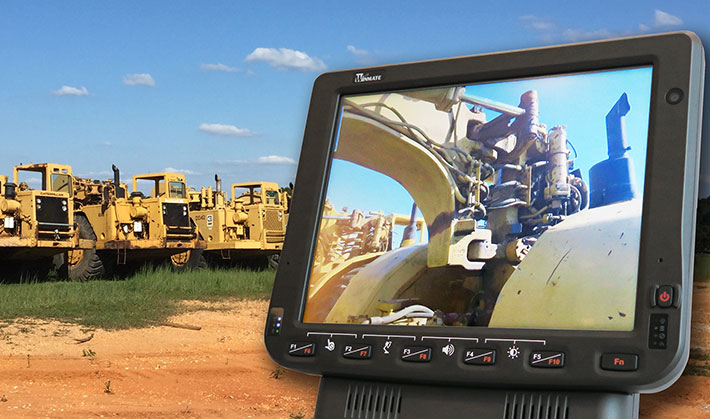
The Winmate FM10 is designed for applications that primarily use touch input on a large display, but also benefit from a number of readily readily accessible programmable function keys. The FM08 and FM10 actually share the system and docking modules, which means that the choice comes down to keypads and smaller 8-inch screen or larger 10.4-inch screen with just function keys.
The Winmate FM Series — modular flexibility
The picture to the right shows the modular approach Winmate took with their FM models. The actual panel computer consists of a front half with the display, a back half with the system board and related circuitry, and then a vehicle dock with extensive and very customizable I/O. The two halves of the panel from a whole and are screwed together.
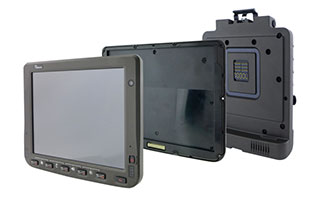 The resulting Panel PC can then be inserted and removed from the dock at any time. In fact, the panel PC can even be used as a panel because it has a fairly powerful internal battery. The resulting Panel PC can then be inserted and removed from the dock at any time. In fact, the panel PC can even be used as a panel because it has a fairly powerful internal battery.
The picture below shows the FM10 from the front and all four sides. There's an ample bezel around the panel's 10.4-inch display that not only allows for significant structural strength, but also five hardware push buttons that make for the equivalent of 10 programmable function keys. The 10.8 x 8.4 inch footprint is compact enough to allow mounting almost anywhere, and despite its very solid construction, the FM10 is just 1.37 inches thick.
The sides of the FM10 are almost completely unadorned. The indents on the top and bottom are for secure parking in the dock, plastic covers on the left and right rear contain internal radio antennae (which are, however, outside of the panel's magnesium alloy housing, there's no fan because none is needed, and the only I/O in the panel itself — a USB 3.0 port, a SIM slot and an microSD card slot) is located beneath a removable protective cover on the right side.
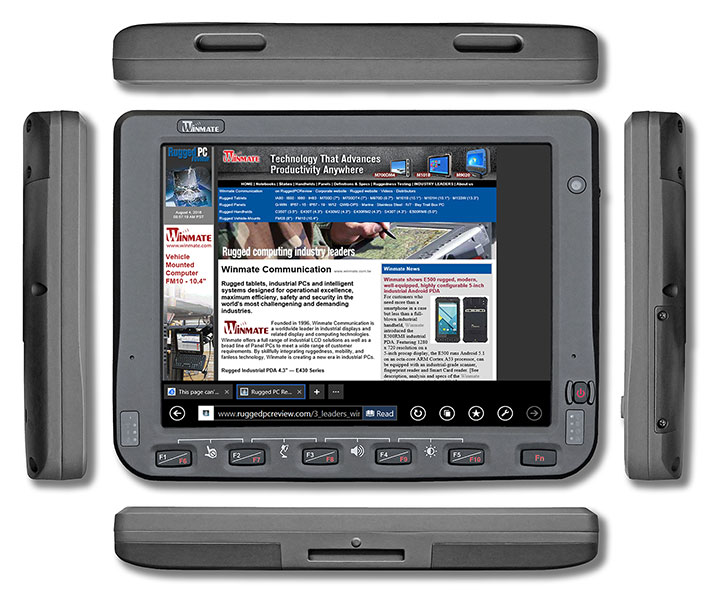
What markets is Winmate trying to reach with their FM Series, and what differentiates the product line? In essence, FM models are for customers who need vehicle-mount computers that are tougher than tablets, offer more I/O than most tablets, can easily be integrated into vehicle power and systems, and also provide superior wireless communication and navigation reception via pass-throughs to vehicle-mount antennae.
Add to that the choice of either a large touch screen with function buttons (the FM10) or a smaller touch screen with full integrated physical keyboard (the FM08), with both having the same exact system module that fits into the same exact vehicle dock.
Meticulous design and construction
From the front, the Winmate FM10 looks almost like a consumer tablet, so when you pick it up you're surprised how solid and heavy it is. Its comparative heft, however, is a feature and not a flaw. While consumer tablets cannot be thin and light enough these days, in an industrial-grade vehicle-mount computer it's toughness and reliability that matter, and the ability to hold up for endless miles of potholes and vibration.
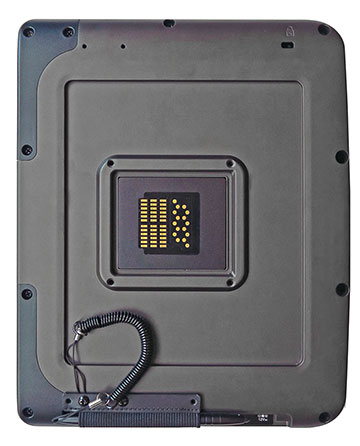 As stated earlier, the Winmate FM Series uses a modular system approach. Even though the panel itself looks like a thick tablet computer, it really consists of a self-contained front part and a self-contained back part. There are no wires between the two and each half has its separate inside plastic cover that protects the guts of its side. All communication between the two halves is via a single fixed-mount edge connector. As stated earlier, the Winmate FM Series uses a modular system approach. Even though the panel itself looks like a thick tablet computer, it really consists of a self-contained front part and a self-contained back part. There are no wires between the two and each half has its separate inside plastic cover that protects the guts of its side. All communication between the two halves is via a single fixed-mount edge connector.
Getting the two halves apart and all opened up isn't difficult but you may get a sore wrist doing so. There are no fewer than 40 small Philips head screws to be undone to get the sides apart and the two protective covers off.
Winmate claims IP65 sealing for the FM10, which is far more than perfunctory protection against an occasional spilled drink. As a result, the FM10 sports a very well designed tongue and groove design with a replaceable rubber pressure seal inside the groove.
As for materials, the two halves are magnesium alloy, the two interior covers PC+ABD polymer plastics.
The front half of the system is what makes the FM10 different from the FM08; the rear of this modular design is identical. The front is as neat and clean as the rear, and taken up mostly of the unit's display, encased in a plastic/metal enclosure that provides stability, protection and shielding. Below you can see the inside of the Winmate FM10:
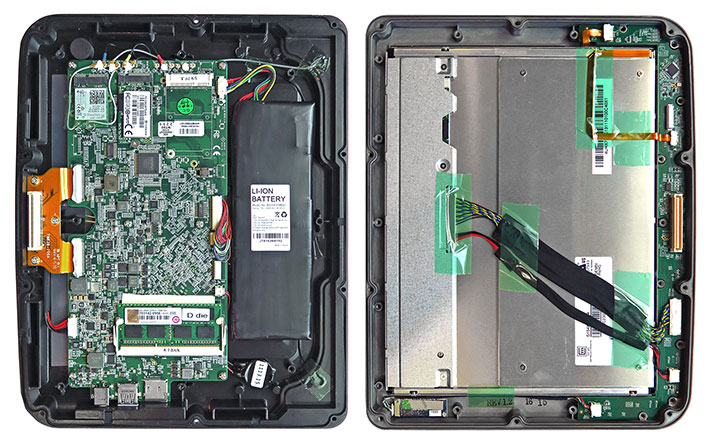
The motherboard measures about 8-1/4 x 4-1/8 inches and is completely accessible once the protective PC+ABS cover is off. Next to the motherboard is the FM10's internal battery. It's a 7.6 Volt, 3,800mAH hour (28.9 watt-hour) Li-Ion pack that's replaceable, but not externally accessible.
Since most FM10s will be using vehicle power, Winmate calls this battery a UPS whose job it is to guard against vehicular power fluctuations or loss. 29 watt-hour, however, mean that this is more than just an emergency bridge battery; the panel ought to run a good while on a fully charged UPS battery.
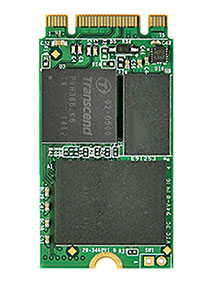 Visible and easily replaceable are the panel's M.2 Transcend TS128GMTS400 solid state disk with a speedy SATA III 6Gb/s interface. Had anyone told me 20 years ago that there'd someday be quite affordable 128GB drives barely larger than a postage stamp, I definitely wouldn't have believed it. Visible and easily replaceable are the panel's M.2 Transcend TS128GMTS400 solid state disk with a speedy SATA III 6Gb/s interface. Had anyone told me 20 years ago that there'd someday be quite affordable 128GB drives barely larger than a postage stamp, I definitely wouldn't have believed it.
Next to it sits an M.2 2230 Intel Dual-Band Wireless-AC 7265 WiFi module that combines fast 802.11ac with dual-mode Bluetooth 4.0 WiFi module.
On the other side of the Transcend SSD is an empty full-size mini-PCIe slot that looks comparatively large combined to the other two. Miniaturization never stops in electronics.
On the other end of the motherboard is the unit's sole RAM slot, populated in our tester by a Transcend 8GB DDR3L 1600 RAM module. As long as we're talking size, it's interesting that memory modules haven't shrunken further in the last few years.
One thing that's interesting (to tech geeks anyway) is that while virtually every electronic circuit board I've ever seen is laid in a strict orthogonal grid like a city plan, the FM10's board has a colony of tiny components that are oriented at a 45-degree angle, as if it were an old town the city planners then built around.
Another interesting aspect of the board is the dearth of edge-mount I/O — just a single USB 3.0 port and the SIM and microSD card slots — because almost all I/O is via the system's elaborate dock. Antenna ports, however, are present in abundance. No fewer than 12 little ports allow connection between radio modules and internal and external antennae.
Also of note is Winmate's dedication to making sure no connectors are vibrating loose on the job — small dollops of white silicon glue see to that.

Finally, above, some details. From left to right, the interesting board layout with its 45-degree angles, the tongue-and-groove sealing design, and the single connector that communicates between the front and back halves of the FM10.
Performance: one size fits most
With general purpose PCs you can never have enough performance, and certainly never too much. It's not the same for industrial PCs that generally run a small number of well-defined applications, and often just one. If that's the case, then it makes absolutely no sense to incur the expense of a high-performance processor and the extra complexity such a processor generally mandates (like fans, heat pipes, heat spreaders, etc).
One could argue, of course, that while the workload of an industrial system is more predictable, different customers may still have very different performance requirements. That's why some of Winmate's competition in vehicle-mount computers offers multiple processor choices, sometimes with a substantial performance range.
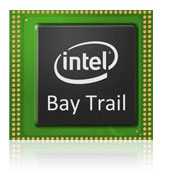 Winmate chose a different approach, betting on a one (processor) size fits all. As a result, the current Winmate FM line is based on one of Intel's most popular workhorse "Bay Trail" CPUs, the quad-core Atom E3845. This is the top-of-the-line of the E3800 product family that Intel described as "the first system-on-chip (SoC) designed for intelligent systems, delivering outstanding compute, graphical, and media performance while operating in an extended range of thermal conditions." Winmate chose a different approach, betting on a one (processor) size fits all. As a result, the current Winmate FM line is based on one of Intel's most popular workhorse "Bay Trail" CPUs, the quad-core Atom E3845. This is the top-of-the-line of the E3800 product family that Intel described as "the first system-on-chip (SoC) designed for intelligent systems, delivering outstanding compute, graphical, and media performance while operating in an extended range of thermal conditions."
The quad-core E3845 has proven an attractive choice in many industrial and vertical market devices because it offers great value for the money. The graphics cores integrated into Bay Trail systems are of the same HD 4000 architecture and variety as those used in Intel's 3rd generation Core processors, yet the E3845 costs less than 1/5th of a typical low-voltage 6th generation dual-core Core i5 processor used in mobile systems.
To provide an idea where the Winmate FM10 stands in terms of overall computing performance, we ran our two standard performance benchmark suites on our evaluation unit. Passmark Software's PerformanceTest 6.1 runs about 30 tests covering CPU, 2D graphics, 3D graphics, memory, and disk and then computes scores for each category and an overall PassMark score. As a cross check, we also always use the CrystalMark benchmark suite that tests various subsystems and then provides an overall score.
For comparison's sake, we included the benchmark data from Winmate's own high-end ultra-rugged M133W tablet equipped with a fast Core processor, one of Advantech's industrial PCs often used in vehicular deployments and equipped with a low-end E3800 Series chip, the performance version of JLT Mobile's VERSO+ 10 panel (which also comes in a version with a low-end Atom chip), and RuggON's VM521 vehicle-mount that uses the same E3845 as the FM10.
The numbers are as follows:
|
Winmate FM10 performance in perspective
|
|
PERFORMANCE COMPARISON
|
Winmate
|
Winmate
|
Advantech
|
JLT Mobile
|
RuggON
|
|
Model
|
FM10
|
M133W
|
TREK-674
|
VERSO+ 10
|
VM521
|
|
|

|

|

|

|

|
|
Year tested
|
2016
|
2016
|
2014
|
2015
|
2016
|
|
What's it for?
|
Vehicle/industrial
|
Mobile tablet
|
Vehicle/surveillance
|
Vehicle/industrial
|
Vehicle/industrial
|
|
Intel processor
|
Atom E3845
|
Core i5-5200U
|
Atom E3827
|
Core i5-4300U
|
Atom E3845
|
|
CPU Speed
|
1.91GHz
|
2.2GHz
|
1.74GHz
|
1.9GHz
|
1.91GHz
|
|
CPU Code name
|
Bay Trail
|
Broadwell
|
Bay Trail
|
Haswell
|
Bay Trail
|
|
OS Software
|
Windows 8.1
|
Windows 8.1
|
WES7
|
Windows 7
|
WES8
|
|
Thermal Design Power (TDP)
|
10 watts
|
15 watts
|
8 watts
|
13 watts
|
10 watts
|
|
CPU Mark
|
1,562.8
|
3,538.4
|
628.7
|
3,519.7
|
1,946.1
|
|
2D Graphics Mark
|
142.8
|
461.3
|
124.9
|
563.6
|
148.4
|
|
Memory Mark
|
487.2
|
981.3
|
314.2
|
1,114.7
|
390.0
|
|
Disk Mark
|
2,037.3
|
2,887.8
|
1,486.9
|
688.5
|
921.5
|
|
3D Graphics Mark
|
141.6
|
321.5
|
125.5
|
434.1
|
133.6
|
|
Overall PassMark
|
954.1
|
1,812.7
|
556.2
|
1,419.7
|
816.7
|
|
CM ALU
|
25,191
|
41,977
|
12,009
|
44,810
|
25,740
|
|
CM FPU
|
21,715
|
39,976
|
9,876
|
41,133
|
21,532
|
|
CM MEM
|
20,242
|
28,556
|
14,748
|
39,430
|
21,143
|
|
CM HDD
|
31,593
|
33,994
|
36,844
|
16,473
|
27,287
|
|
CM GDI
|
4,667
|
14,409
|
3,465
|
17,630
|
4,921
|
|
CM D2D
|
3,709
|
6,815
|
3,490
|
8,318
|
3,764
|
|
CM OGL
|
3,145
|
10,106
|
2,667
|
11,951
|
3,120
|
|
Overall CrystalMark
|
110,262
|
175,833
|
83,099
|
179,745
|
107,507
|
Let me emphasize once again that the above numbers are not meant to be a comparison between competing systems, but just as an illustration of what customers can expect from this Winmate vehicle-mount computer.
With that in mind, a rough answer is that the E3845-based system can provide about 60% of the bottomline performance a typical high-end industrial Intel Core processor-based device, but it is considerably faster than a system equipped with on of the low-end Bay Trail Atom chips. And do note the great impact the type of mass storage has on overall performance. The speedy solid state disk Winmate gave the FM10 greatly helps performance.
Bottomline here: the economical Intel E3845 quad-core processor in the Winmate FM10 should be plenty powerful enough for most vehicular deployments. It does, however, not include some of the proprietary Intel technologies baked into higher-end Intel Core processors. Those may or may not be needed.
Power
The FM10 was designed a vehicle-mount computer that primarily draws operating power through its vehicle dock. Since vehicle electrical systems voltage vary (12 Volt in most civilian vehicles, 28 Volt in US military vehicles, proposed 42 and 48 Volt in future automotive systems), Winmate designed the FM Series dock to accept a very wide range of 10 to 60 VDC without the need to switch voltage.
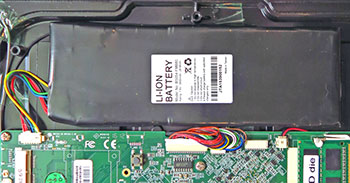 However, due to the compact size and low weight of the FM10, it's conceivable that the device may be moved between vehicles, or even used outside of vehicles and away from its dock. However, due to the compact size and low weight of the FM10, it's conceivable that the device may be moved between vehicles, or even used outside of vehicles and away from its dock.
For that Winmate gave the FM10 an internal "UPS" battery. UPS stands for Uninterruptible Power Supply and generally means a short-term emergency backup for when power goes out or there are power fluctuations.
Winmate says the battery is designed to provide power for a minimum of 30 minutes. That's quite an understatement. When we measured the power draw of the FM10, we recorded 5.5 watts with the backlight at its lowest, and 10.3 watts with the backlight full-bright. Given the internal Li-Ion battery's 28.8 watt-hour capacity, this means theoretical running times between 2..8 hours and a full 5.1 hours.
Dock and mounting options
While, thanks to its rather powerful internal battery, the FM10 can be used as a tablet away from the vehicle or wherever it is mounted, the FM Series panel and dock are part of a system. The dock should not be viewed as an accessory, but rather as an inherent part of an FM panel. That's evident in Winmate's decision to place most I/O into the dock.
The image below shows the backside of the FM10 as well as a side view. Clearly visible is the separation of the minimal I/O block in the slender system unit itself (just a USB port and SD and SIM card slots), and then the full-size ports in the docking module. Shown in the illustration are two legacy serial ports, a USB port, a CANBus/audio port (either one or the other via adapter cable), and an RJ45 LAN jack. Also note the three different VESA mount patterns and the dock's WiFi, GPS and WWAN connections.
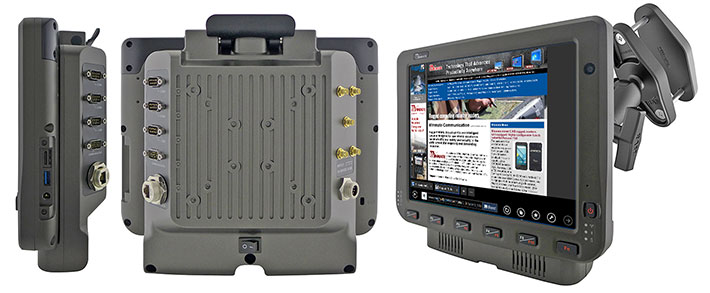
The back of the dock shows the standard VESA 75 and 100 mount patterns as well as RAM Mount screw holes. There's also a Kensington lock slot, a lockable quick-release latch, a power switch that connects to the vehicle's ignition system, dual speakers, and even an LED reading light. On the software side, Winmate provides an ignition software utility to control the timing of on/off delay.
For applications that require a keyboard for rapid data entry there are NEMA4-sealed keyboards, and there's also a variety of bare leads and quick-connect cables for installation, and more.
High contrast display
With displays, it's much the same situation as with processing power. In a desktop system, the larger, brighter, and higher resolution a display is, the better. But that's not necessarily the case in mobile and industrial systems.
Anything mounted in a vehicle, for example, must be compact enough to easily fit into the vehicle without taking up too much space or impact other controls, but it also must be large enough to allow the full use of Windows applications.
While higher resolution is almost always better in consumer devices, that may not necessarily be the case in vehicle-mounts where a lot of industry-specific software has been written for certain standard resolutions and aspect ratios for years and decades.
And while brilliant color and perfect viewing angles are prized in smartphones, laptops and, especially, tablets, vehicle mounts are pretty much always viewed from the same angle, and different display qualities, such as superior contrast, may be more important.
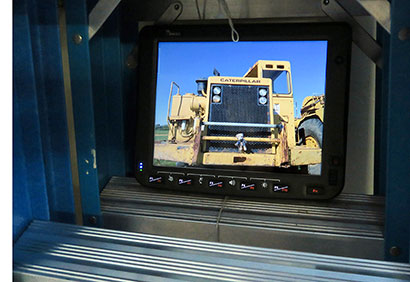 With all of this in mind, Winmate gave the FM10 an industrial-grade 10.4" 1024 x 768 pixel LCD sourced from from Chi Mei Optoelectronics which is now part of Innolux and the world's second largest maker of TFT-LCD panels. 10.4 inches diagonal is about as large a screen size as can feasibly be mounted in many vehicles. With all of this in mind, Winmate gave the FM10 an industrial-grade 10.4" 1024 x 768 pixel LCD sourced from from Chi Mei Optoelectronics which is now part of Innolux and the world's second largest maker of TFT-LCD panels. 10.4 inches diagonal is about as large a screen size as can feasibly be mounted in many vehicles.
Combined with its 4:3 aspect ratio, this is an extremely well-liked display size, as evidenced by the many hundreds of millions of tablets of this size sold.
1024 x 768 pixel XGA resolution has long been the industry standard for many industrial and vertical market laptops, tablets and panels, and has huge software support. On a 10.4-inch display that makes for 123 pixels per inch, not very sharp by today's super-high resolution "retina" display standards, but just fine for most vehicular applications. In fact, 123ppi is about what all pre-retina Apple MacBook laptops had, and few ever complained about that.
As far as brightness goes, Winmate claims 400 nits, which is about twice as bright as your average consumer laptop, and about as bright as an Apple iPad Air 2.
As for the particular type of screen, it's a Chi Mei G104X1-L04 super-MVA LCD panel. MVA stands for Multi-domain Vertical Alignment. MVA is a technology that offers viewing angles from all directions almost as good as IPS displays, albeit with very slight color shifts. The primary reason why Winmate used super-MVA for their FM Series panels is likely the technology's excellent contrast ratio that generally surpasses that of IPS screens.
GFG resistive touch
There was a time when touch screens essentially came in two varieties. Those with active digitizers provided maximum precision and cursor tracking, and were primarily used for art, digital inking, and as mouse replacements when using Windows on a tablet. Those with passive resistive digitizers allowed for quick tapping on the screen with a stylus or even a finger.
Then came capacitive touch with its effortless tapping, panning, pinching and zooming, and it quickly took over the consumer market. Capacitive touch took a lot longer to become accepted in vertical market products, for a variety of reasons. One was that classic Microsoft Windows, designed for use with a mouse or a point stylus, never worked well with just tapping a finger on all of Windows' tiny check boxes, scrollers, and pulldown menus. Another was that standard capacitive touch initially didn't work at all with gloves on or in the rain. And in the field it often does rain, and workers are wearing gloves.
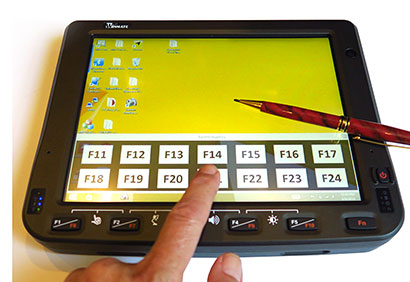 Advances in capacitive touch added a degree of functionality in wet conditions and with gloves on, but use in demanding conditions remains a weak part of the glamorous capacitive multi-touch. as a result, Winmate decided to go with resistive touch for the Windows versions of the FM line (a newly introduced Android version uses capacitive touch). Advances in capacitive touch added a degree of functionality in wet conditions and with gloves on, but use in demanding conditions remains a weak part of the glamorous capacitive multi-touch. as a result, Winmate decided to go with resistive touch for the Windows versions of the FM line (a newly introduced Android version uses capacitive touch).
One problem with generic resistive touch is that the surface film is scratch- and damage-prone, and can introduce distracting optical properties, like the "pooling" that happens when the soft touch surface is depressed.
So Winmate decided to use GFG — Glass-Film-Glass — resistive technology that employs a highly scratch-resistant very thin glass on top of the resistive layer. Additional advantages of GFG include greater corrosion-resistance, greater temperature-resistance, ease of cleaning with a wide range of cleaning agents, and, especially important in vehicular applications, in case of an accident, GFG panels don't shatter.
Winmate went all out to optimize the FM10 for easy use with just touch. There are the shiftable, combinable and programmable physical function buttons that provide the conventional PC F1 to F10 function keys. In addition, there are programmable soft function buttons F11 to F24.
Operating systems
Winmate makes the FM10 available with a variety of different operating systems. Those include Windows 7 Professional for Embedded Systems as the default, Windows Embedded Standard 7, Windows Embedded 8.1 Industry Pro, and the new Windows 10 IoT Enterprise, all presumably in their respective 64-bit versions. Which is best suited for the FM10? That depends on the intended application and deployment.
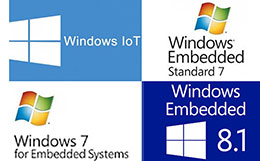 The test machine Winmate sent us came with Windows Embedded 8.1 Industry Pro, but many units will undoubtedly still be ordered with Windows Embedded Standard 7 or Windows 7 Professional for Embedded Systems. This being an industrial panel, no general purpose OS is offered. The test machine Winmate sent us came with Windows Embedded 8.1 Industry Pro, but many units will undoubtedly still be ordered with Windows Embedded Standard 7 or Windows 7 Professional for Embedded Systems. This being an industrial panel, no general purpose OS is offered.
Of the available four operating system choices,
- Windows Embedded Standard 7 is a customizable and componentized version of Windows 7 for applications where a minimal footprint is desirable. WES7 can take as little as 300MB.
- Windows 7 Professional for Embedded Systems is a full Windows 7 OEM version, but licensed only for use in embedded devices, and with long lifetime support (at least 2024).
- Windows Embedded 8.1 Industry Pro is a customizable and componentized version of Windows 8.1, available preinstalled on OEM devices, with a number of special features for industrial application, and minus consumer items like the Windows Store or marketplace and such.
- Windows 10 IoT Enterprise replaced Windows Embedded 8.1 Industry Pro. It's the full version of Windows 10, but includes advanced lockdown features, and needs at least 16GB of storage.
Note that all embedded versions of Windows are designed for the much longer product life cycle and support requirements of industrial computing systems. A general policy is 15 years of product availability and ten years of support (usually five years mainstream and then five years extended).
Also note that configuring and building an embedded Windows image requires considerable expertise. Winmate has been working with embedded versions of Windows for many years and can develop and manage customer images.
Ruggedness
The required ruggedness characteristics of a vehicle-mount computer are different from those of a rugged mobile system. Vehicle-mounts aren't generally carried around and thus aren't likely be dropped as will inevitably happen to handhelds and tablets. They will, however, be subjected to much more vibration and shock.
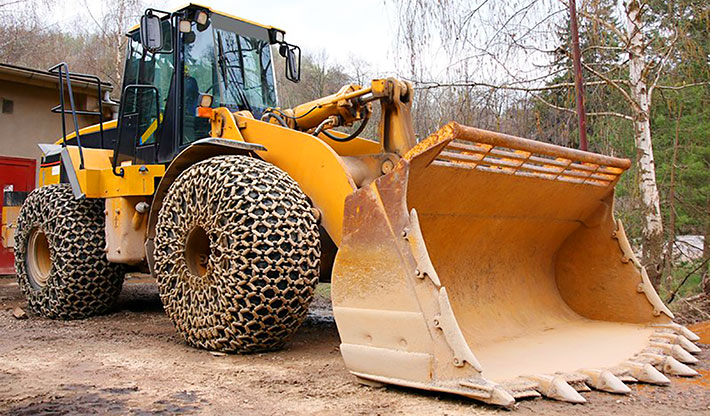
The FM10's -22 to 122 degree Fahrenheit operating temperature range allows deployment in a very wide range of settings, including industrial freezers and similar. And since, unlike fixed-mounts, vehicle-mounts may be operated outdoors, FM10 units have an IP65 ingress protection rating where the first "6" indicates the unit is totally dustproof and the "5" that the unit can also handle low pressure jets of water.
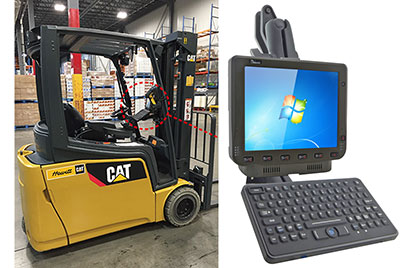 The machine can handle 5 - 95% relative humidity. It is compliant with MIL-STD-810G Method 516.6 Procedure I for functional shock (i.e. assessing physical integrity, continuity and functionality while installed), and Method 514.6 Procedure I for vibration (i.e. using vibration shakers are used for fixed vehicle mount simulation testing). The machine can handle 5 - 95% relative humidity. It is compliant with MIL-STD-810G Method 516.6 Procedure I for functional shock (i.e. assessing physical integrity, continuity and functionality while installed), and Method 514.6 Procedure I for vibration (i.e. using vibration shakers are used for fixed vehicle mount simulation testing).
Do realize that shock and vibration resistance are the most important ruggedness criteria for a vehicle-mount system. And also that proper mounting is of crucial importance in minimizing the overall potential for damage in a vehicle-mount.
Subjectively, the FM10 and its dock feel exceedingly solid and well-made. The fit and finish are of very high quality. Given the importance of ruggedness testing for this class of device, we'd encourage Winmate to make available full certified ruggedness testing reports and results on its website and also include more detailed ruggedness information in its product literature.
The Winmate FM10: bottom line
The FM10 is part of Taiwanese Winmate Communications' modular lineup of Intel Bay Trail-based vehicle-mount computers. The line was designed for use in a wide variety of commercial, industrial and government use. Goals included a cost-saving modular approach via common docks, system units, peripherals and accessories.
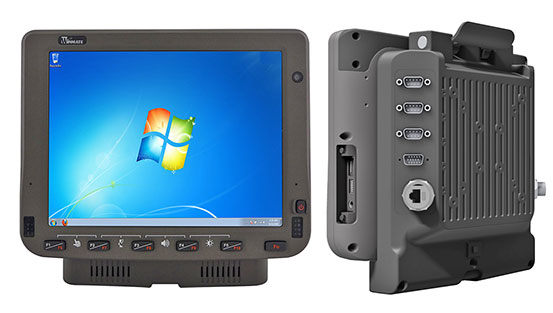 Unlike many panel computers, the FM10 can be operated either on vehicle power or use its own internal battery. That allows for seamless move between vehicles and locations, as well as occasional use as a self-contained mobile tablet. The latter is aided by the FM10's compact size and modest 3.9-pound weight.
Unlike many panel computers, the FM10 can be operated either on vehicle power or use its own internal battery. That allows for seamless move between vehicles and locations, as well as occasional use as a self-contained mobile tablet. The latter is aided by the FM10's compact size and modest 3.9-pound weight.
The FM1's 10.4-inch offers good brightness, very good viewing angles from all directions, and exceptional contrast. Its resistive touch screen is well suited for its intended deployments, and provides extra strength and protection via its Glass-Film_Glass technology. Touch operation isn optimized via 10 programmable physical function keys and an additional 14 soft function keys.
Powered by an Intel E3845 quad-core processor, the FM10 provides a good balance between performance and low enough power draw to allow fanless operation. Wired connectivity is split between onboard basics (power, USB, expansion cards) and an extensive complement (USB, LAN, COM, CANBus, audio) on the highly integrated dock that also offers WiFi, GOS and WWAN external antenna pass-throughs.
The Winmate FM10's elegant, functional magnesium alloy housing feels invulnerable. It offers IP65 sealing, has a wide operating temperature range (-22 to 122 degrees Fahrenheit), and it's been extensively tested for sock and vibration resistance. It also offers a wide variety of mounting options as well as an external keyboard.
With the FM10, Winmate offers a well-conceived, well-executed modular vehicle-mount computing solution that provides superior flexibility both in terms of configuration possibilities as well as in very wide application potential.
-- Conrad H. Blickenstorfer, August 2016
Specifications Winmate FM10:
| Added/changed |
Added 10/2015, full review 08/2016
|
| Type |
Rugged fanless vehicle-mount PC
|
| Processor |
Intel "Bay Trail" Atom E3845
|
| Processor clock speed |
1.91GHz
|
| Processor TDP speed |
10 watts
|
| Graphics |
Intel HD Graphics (Intel Gen7 with DX11, OGL 3.2)
|
| OS |
Windows 10 IoT Enterprise, Windows Embedded 8.1 Industry Pro (in review system), Windows 7 Pro FES (default), WES 7
|
| Standard/Max RAM |
Up to 8GB DDR3L 1600MHz in one SD-DIMM slot
|
| Disk/drive |
64GB to 256GB M.2 MLC SSD
|
| Display type |
Sunlight-readable IPS TFT LCD with 88/88/88/88 degree viewing angle |
| Display size/resolution |
10.4"/1024 x 768 pixel 123 ppi XGA (400 nits) |
| Digitizer |
GFG resistive touch (finger touch and stylus)
|
| Keyboard/keys |
Onscreen, 10 function keys
|
| Navigation |
Touch
|
| Expansion slots |
1 x SD Card, 1 x SIM
|
| Housing |
Magnesium Alloy housing with fanless design
|
| Size |
Panel: 10.6 x 8.4 x 1.37 inches (268 x 214 x 35 mm), dock: 7.9 x 9.6 x 2.04 inches (202 x 245 x 52 mm)
|
| Weight |
Panel itself 3.9 lbs (1.8kg) as tested, docking 3.5 lbs (1.6kg) as tested
|
| Operating temperature |
-22° to 122°F (-30° to 50°C) |
| Ingress protection |
IP65 - IEC 60529:2001 (totally dustproof, sealed against low pressure water jets from all directions) |
| Humidity |
10-95% RH, non-condensing |
| Shock |
3MIL-STD-810G Method 516.6 Procedure I |
| Vibration |
MIL-STD-810G Method 514.6 Procedure I |
| Altitude |
810G in applicable areas |
| ESD |
Unknown |
| Power |
10~60V DC; 7.6 V 3,800 mAH 28.9 watt-hour Li-Ion backup/UPS |
| Camera |
2MP Camera at front side (only available on Windows 7/ 8.1/ 10 IoT) |
| Communication |
Dual-band 802.11 a/b/g/n/ac WiFi, Class 1 Bluetooth 4.0, u-Blox NEO-6Q GPS, optional 3G (HSPA+, GSM/GPRS/EDGE) or 4G (LTE, HSPA+, GSM/GPRS/EDGE, EV-DO Rev A, 1xRTT) WWAN
|
| Interface |
Panel itself: 1 x USB 3.0, power; dock: 1 x USB 2.0, 1 x RJ45 10/100/1000 with PoE support, 2 x RS232, 1 x CANBUS/audio, SMA for external antenna
|
| Price |
Inquire |
| Spec sheet |
 Winmate FM10 spec sheet (PDF) Winmate FM10 spec sheet (PDF)
|
| Web page |
Winmate FM10 web page |
| Contact |
Winmate Inc.
9F, No. 111-6, Shing-De Road
San-Chung City, Taipei, Taiwan 241, R.O.C.
Fax: +886-2-85110211
Web: www.winmate.com
|
Winmate North America
3348 Peachtree RD, Suite 700
Atlanta, GA 30326, USA
Phone: +1-678-954-4889
Fax: +1-404-233-1800
Web: www.winmate-rugged.com
|
|





